Design and Experiment of Seed-Cleaning Mechanism for Inside-Filling Pneumatic Cotton Precision Seed-Metering Device
Abstract
:1. Introduction
2. Materials and Methods
2.1. Structure and Operating Principle of Seed-Metering Device
2.2. Re-Adsorption Phenomenon and Analysis of the Seed-Cleaning Process
2.2.1. Re-Adsorption Phenomenon
2.2.2. Analysis of the Seed-Cleaning Process
Analysis of the Seed-Cleaning Scraper
Analysis of the Seed-Disturbing Air Nozzle
2.3. Design of the Seed-Cleaning Mechanism
2.3.1. Design of the Seed-Cleaning Scraper
Installation Position of the Seed-Cleaning Scraper
Determination of Key Parameters for the Seed-Cleaning Scraper
- (1)
- Front Part Width (a) and Top Radius (Rd)
- (2)
- Seed-Cleaning Part’s Thickness (b) and Seed-Cleaning Part’s Extended Length (c)
- (3)
- Scraper Shape
2.3.2. Design of the Seed-Disturbing Air Nozzle
Determination of the Inclination Angle of Outlet Section for the Seed-Disturbing Air Nozzle
Determination of Key Parameters for the Seed-Disturbing Air Nozzle
2.4. Seed-Cleaning Performance Test of Inside-Filling Pneumatic Precision Seed-Metering Device
2.4.1. Test Materials and Equipment
2.4.2. Test Method and Evaluation Indexes
2.4.3. Test Design
- (1)
- The seed-disturbing air nozzle was removed, and the single-sided seed-cleaning scraper was adopted as the seed-cleaning mechanism. The single-factor comparison test was conducted for the flat and sharp seed-cleaning scrapers, as shown in Figure 7, under different seed-cleaning distances to investigation the influence law of scraper shape on seed-cleaning effect and obtain the optimal scraper shape. The seed-cleaning distance was set as 0.5–4.5 mm, with an interval of 0.5 mm. Each group of tests was repeated 3 times, and the mean values were recorded to be the evaluation indexes.
- (2)
- The optimal seed-cleaning scraper shape obtained from the above test was combined with the seed-disturbing air nozzle as the combined seed-cleaning mechanism of the seed-metering device. A Box–Behnken Design test was executed, taking the seed-cleaning distance, seed-disturbing distance, and seed-disturbing pressure as impact factors for exploring the influencing of the impact factors on the evaluation indexes. From the previous pre-test, it was found that the seed-cleaning performance was good when the seed-cleaning distance, seed-disturbing distance, and seed-disturbing pressure were set to 0.5–4.5 mm, 4.0–8.0 mm, and 200–3000 Pa, respectively. Moreover, the test levels for the test factors are shown in Table 1. A total of 17 groups were tested. Each group was duplicated 3 times, and the mean values were recorded to be evaluation indexes.
3. Results and Discussion
3.1. Single-Factor Comparison Test on the Shape of the Seed-Cleaning Scraper
3.2. Box–Behnken Test on the Combined Seed-Cleaning Mechanism
3.2.1. Significance Analysis and Regression Model
3.2.2. Effect of Interaction Factors on Seed-Cleaning Performance
3.2.3. Parameter Optimization
3.3. Discussion
4. Conclusions
- (1)
- Aiming to address the problem of the poor seed-cleaning performance of the inside-filling pneumatic cotton precision seed-metering device, a double-sided seed-cleaning mechanism combining a seed-cleaning scraper and seed-disturbing air nozzle was designed. The key structure and parameters of the seed-cleaning mechanism were determined by combining theoretical analysis and operational requirements.
- (2)
- The results of single-factor comparison test revealed that, no matter what shape of seed-cleaning scraper was adopted for the seed-metering device, the missing cleaning rates under the corresponding optimal seed-cleaning effect were greater than 5%, and the sharp scraper gave a better seed-cleaning performance than the flat scraper.
- (3)
- The results of the Box–Behnken Design test indicated that all the test factors were highly significant on evaluation indexes. The order of each test factor affecting the evaluation indexes was as follows: seed-cleaning distance > seed-disturbing pressure > seed-disturbing distance. The optimal combination of parameters was as follows: 3.1 mm for seed-cleaning distance, 6.2 mm for seed-disturbing distance, and 2165 Pa for seed-disturbing pressure. Moreover, the evaluation indexes of the validation tests based on the optimized parameter values were as follows: 98.03% for single seed rate, 1.42% for missing cleaning rate, and 0.55% for excessive cleaning rate.
- (4)
- In comparison with the optimal seed-cleaning effects under the single-sided seed-cleaning scrapers of flat and sharp shape, respectively, the combined double-sided seed-cleaning mechanism reduced 3.90 and 3.61 percentage points in missing cleaning rate, reduced 2.02 and 1.17 percentage points in excessive cleaning rate, and increased 5.92 and 4.78 percentage points in single seed rate, indicating that the combined double-sided seed-cleaning mechanism can effectively improve the seed-cleaning effect of inside-filling pneumatic seed-metering device.
Author Contributions
Funding
Institutional Review Board Statement
Data Availability Statement
Acknowledgments
Conflicts of Interest
References
- Mao, S.C.; Li, Y.B.; Dong, H.Z.; Bie, S.; Lin, Y.Z.; Dong, H.L. Cotton Cultivation in China, 1st ed.; Shanghai Science and Technology Press: Shanghai, China, 2013; pp. 55–65. [Google Scholar]
- Ni, X.D.; Xu, G.J.; Wang, Q.; Peng, X.R.; Wang, J.; Hu, B. Design and Experiment of Pneumatic Cylinder Array Precision Seed-metering Device for Cotton. Trans. Chin. Soc. Agric. Mach. 2017, 48, 58–67. [Google Scholar]
- Xu, G.J. Design and Experiment of Pneumatic Cylinder Array Precision Seed-Metering Device for Cotton. Master’s Thesis, Shihezi University, Shihezi, China, 2018. [Google Scholar]
- Braunack, M.V.; Johnston, D.B.; Price, J.; Gauthier, E. Soil temperature and soil water potential under thin oxodegradable plastic film impact on cotton crop establishment and yield. Field Crop. Res. 2015, 184, 91–103. [Google Scholar] [CrossRef]
- Sun, Y.T.; Tian, L.Z.; Shang, S.Q.; Yang, R.B.; Wang, Y.Y.; Zhao, J.L. Experimental research on inside-filling metering device for peanut seeder. Trans. CSAE 2012, 28, 84–89. [Google Scholar]
- China Academy of Agricultural Mechanization Science. Agricultural Machinery Design Manual, 1st ed.; China Agricultural Science and Technology Press: Beijing, China, 2007; pp. 343–345. [Google Scholar]
- Du, X.; Liu, C.L.; Jiang, M.; Zhang, F.Y.; Yuan, H.; Yang, H.X. Design and experiment of self-disturbance inner-filling cell wheel maize precision seed-metering device. Trans. CSAE 2019, 35, 23–34. [Google Scholar]
- Liu, J.; Cui, T.; Zhang, D.X.; Yang, L.; Shi, S. Mechanical-pneumatic combined corn precision seed-metering device. Trans. Chin. Soc. Agric. Mach. 2012, 43, 43–47. [Google Scholar]
- Li, B.F. Agricultural Machines, 1st ed.; China Agricultural Press: Beijing, China, 2003; pp. 61–62. [Google Scholar]
- Jia, H.L.; Chen, Y.L.; Zhao, J.L.; Wang, J.X.; Guo, M.Z.; Zhuang, J. Design and experiment of pneumatic-mechanical combined precision metering device for soybean. Trans. Chin. Soc. Agric. Mach. 2018, 49, 75–86. [Google Scholar]
- Yazgi, A.; Degirmencioglu, A. Optimisation of the seed spacing uniformity performance of a vacuum-type precision seeder using response surface methodology. Biosyst. Eng. 2007, 97, 347–356. [Google Scholar] [CrossRef]
- Xing, H.; Wang, Z.M.; Luo, X.W.; He, S.Y.; Zang, Y. Mechanism modeling and experimental analysis of seed throwing with rice pneumatic seed metering device with adjustable seeding rate. Comput. Electron. Agric. 2020, 178, 105697. [Google Scholar] [CrossRef]
- Wang, B.L.; Na, Y.; Liu, J.; Wang, Z.M. Design and Evaluation of Vacuum Central Drum Seed Metering Device. Appl. Sci. 2022, 12, 2159. [Google Scholar] [CrossRef]
- Li, B.H.; Ahmad, R.; Qi, X.D.; Li, H.; Nyambura, S.M.; Wang, J.F.; Chen, X.; Li, S.B. Design Evaluation and Performance Analysis of a Double-Row Pneumatic Precision Metering Device for Brassica chinensis. Sustainability 2021, 13, 1374. [Google Scholar] [CrossRef]
- Sun, X.P.; Li, H.; Qi, X.D.; Nyambura, S.M.; Yin, J.Q.; Ma, Y.L.; Wang, J.S. Performance Parameters Optimization of a Three-Row Pneumatic Precision Metering Device for Brassica chinensis. Agronomy 2022, 12, 1011. [Google Scholar] [CrossRef]
- Xu, J.; Hou, J.W.; Wu, W.B.; Han, C.Y.; Wang, X.M.; Tang, T.; Sun, S.L. Key Structure Design and Experiment of Air-Suction Vegetable Seed-Metering Device. Agronomy 2022, 12, 675. [Google Scholar] [CrossRef]
- Shi, S.; Zhou, J.L.; Liu, H.; Fang, H.M.; Jian, S.C.; Zhang, R.F. Design and experiment of pneumatic precision seed-metering device with guided assistant seed-filling. Trans. Chin. Soc. Agric. Mach. 2019, 50, 61–70. [Google Scholar]
- Shi, S.; Liu, H.; Zhou, J.L.; Jian, S.C.; Zhang, R.F. Optimization and Experiment of Pneumatic Seed Metering Device with Guided Assistant Filling Based on EDEM-CFD. Trans. Chin. Soc. Agric. Mach. 2020, 51, 54–66. [Google Scholar]
- Li, Z.D.; Yang, W.C.; Wu, Y.Y.; He, S.; Wang, W.W.; Chen, L.Q. Performance analysis and experiments of seed filling assisted by groove-tooth of pneumatic disc precision metering device for rapeseed. Trans. CSAE 2020, 36, 57–66. [Google Scholar]
- Lai, Q.H.; Ma, W.P.; Liu, S.; Su, W.; Zhang, Z.H. Simulation and experiment on seed-filling performance of pneumatic disc seed-metering device for mini-tuber. Trans. Chin. Soc. Agric. Mach. 2017, 48, 44–53. [Google Scholar]
- Hu, M.J.; Xia, J.F.; Zheng, K.; Du, J.; Liu, Z.Y.; Zhou, M.K. Design and Experiment of Inside-filling Pneumatic High Speed Precision Seed-metering Device for Cotton. Trans. Chin. Soc. Agric. Mach. 2021, 52, 73–85. [Google Scholar]
- Li, J.J.; Zhang, H.P.; Bi, X.S.; Wang, J.; Hu, B.; Li, S.Z. Simulation analysis and test on the filling performance of rotary type-hole precision seed-metering device for cotton. Trans. CSAE 2020, 36, 38–49. [Google Scholar]
- Liu, Y.Q.; Liu, L.J.; Zhao, Z.B.; Zhao, J.H.; Cui, W. Design and Experiment on Plant Seedling Device for Vegetable Seedling Seeder. Trans. Chin. Soc. Agric. Mach. 2018, 49, 83–91. [Google Scholar]
- Qi, B.; Zhang, D.X.; Liu, Q.W.; Yang, L.; Shi, S.; Cui, T. Design and experiment of cleaning performance in a centralized pneumatic metering device for maize. Trans. CSAE 2015, 31, 20–27. [Google Scholar]
- Ding, L.; Yang, L.; Zhang, D.X.; Cui, T. Parametric design and test of seed cleaning mechanism of air-suction maize seed-metering device. Trans. Chin. Soc. Agric. Mach. 2019, 50, 47–56. [Google Scholar]
- Li, Y.H.; Yang, L.; Zhang, D.X.; Cui, T.; He, X.T.; Hu, H. Design and test of double-side cleaning mechanism for air-suction maize seed-metering device. Trans. Chin. Soc. Agric. Mach. 2021, 52, 29–39. [Google Scholar]
- Wang, J.K. Study on Motion Characteristics of Cottonseed in Dibbler and Mechanism of Clamping Seeding. Ph.D. Thesis, Northwest A&F University, Yangling, China, 2010. [Google Scholar]
- Zhang, B.P. Seeding Machine Design Principles, 1st ed.; Machinery Industry Press: Beijing, China, 1982; pp. 316–317. [Google Scholar]
- Cai, Z.J.; Long, T.Y. Fluid Mechanics Pumps and Fans, 4th ed.; China Construction Industry Press: Beijing, China, 1999; pp. 156–157. [Google Scholar]
- Jiang, Y.; Shi, S.Y.; Niu, Y.S. Space Launch Science and Technology Launch Gas Dynamics, 1st ed.; Beijing Institute of Technology Press: Beijing, China, 2015; pp. 13–14. [Google Scholar]

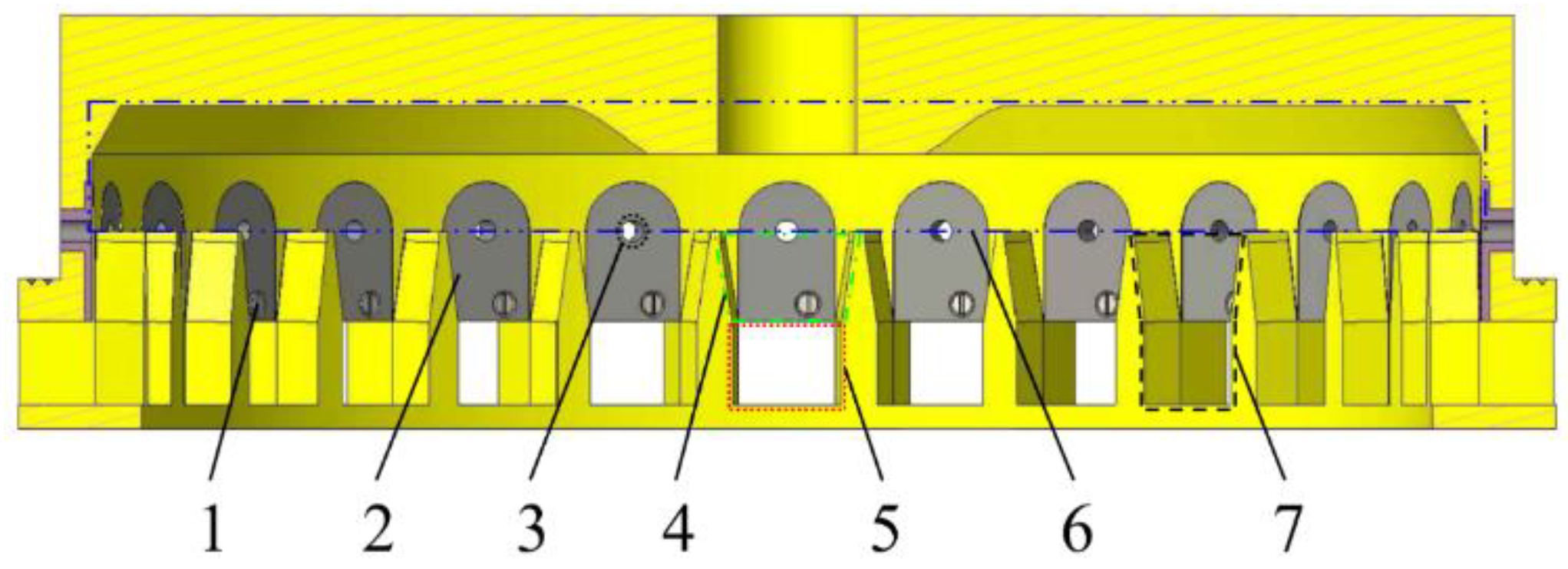

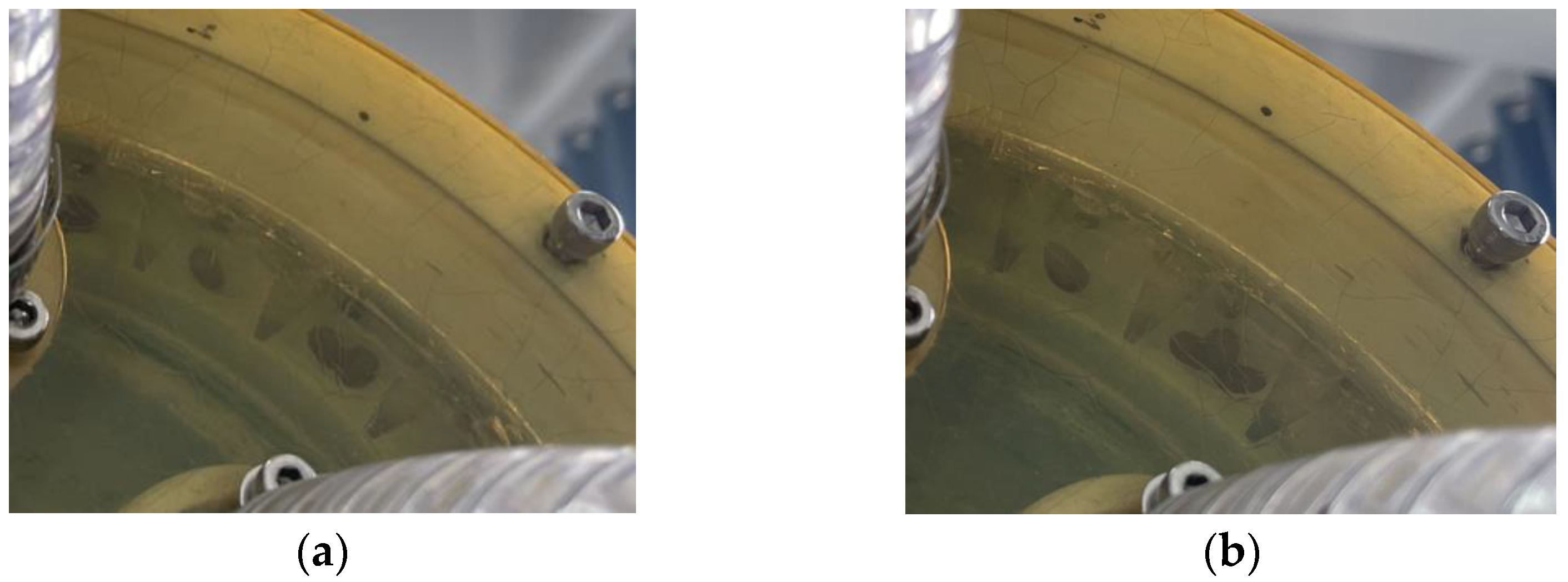
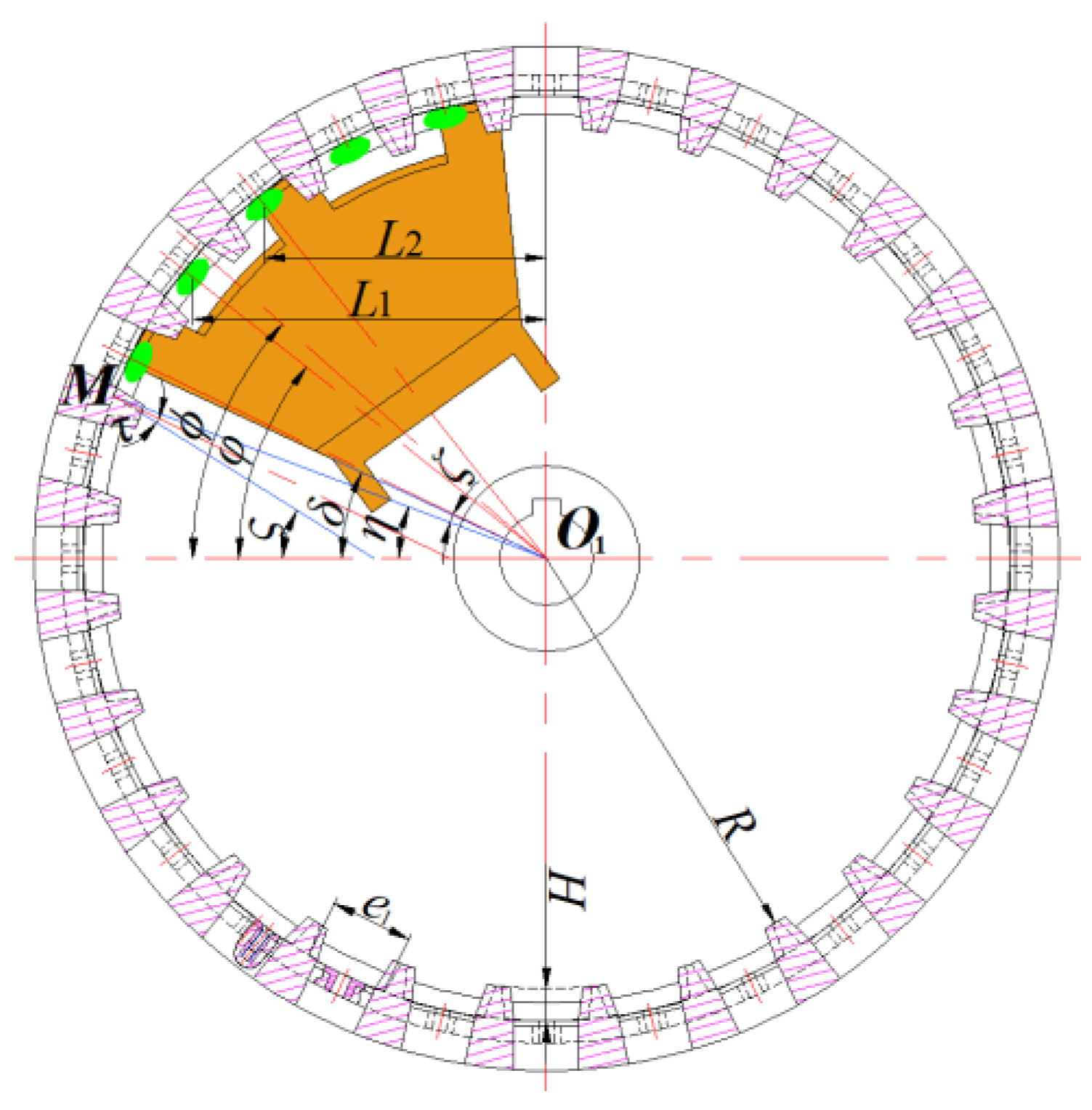


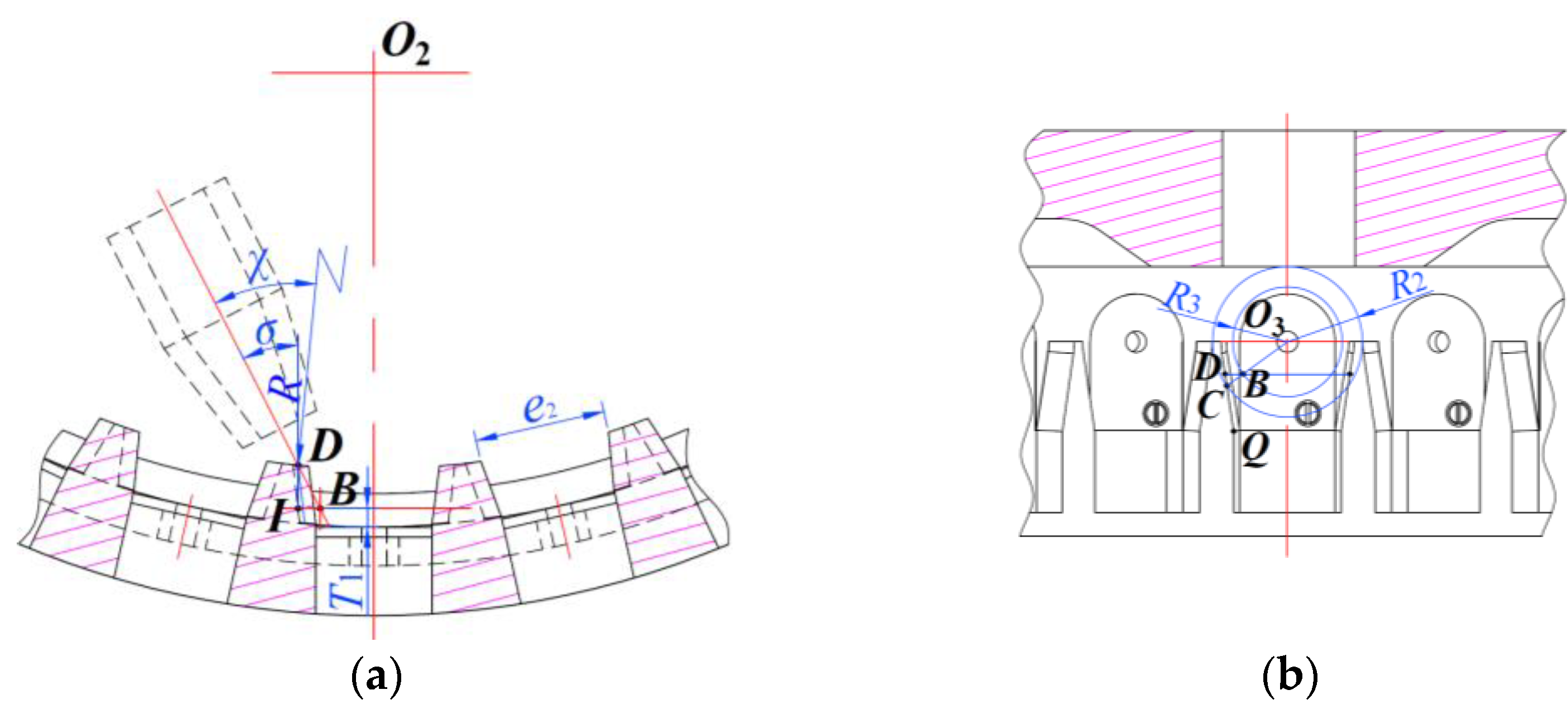

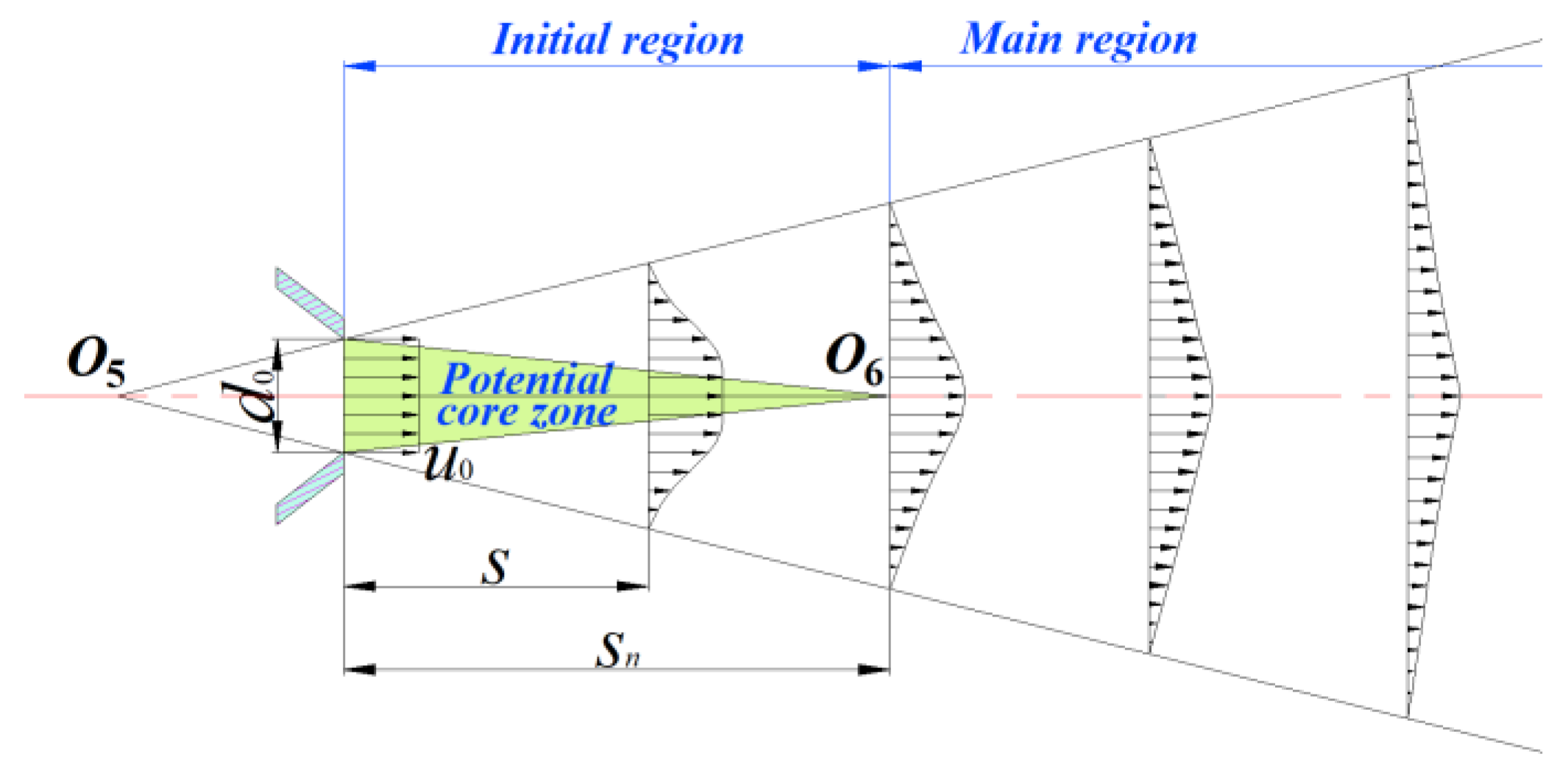
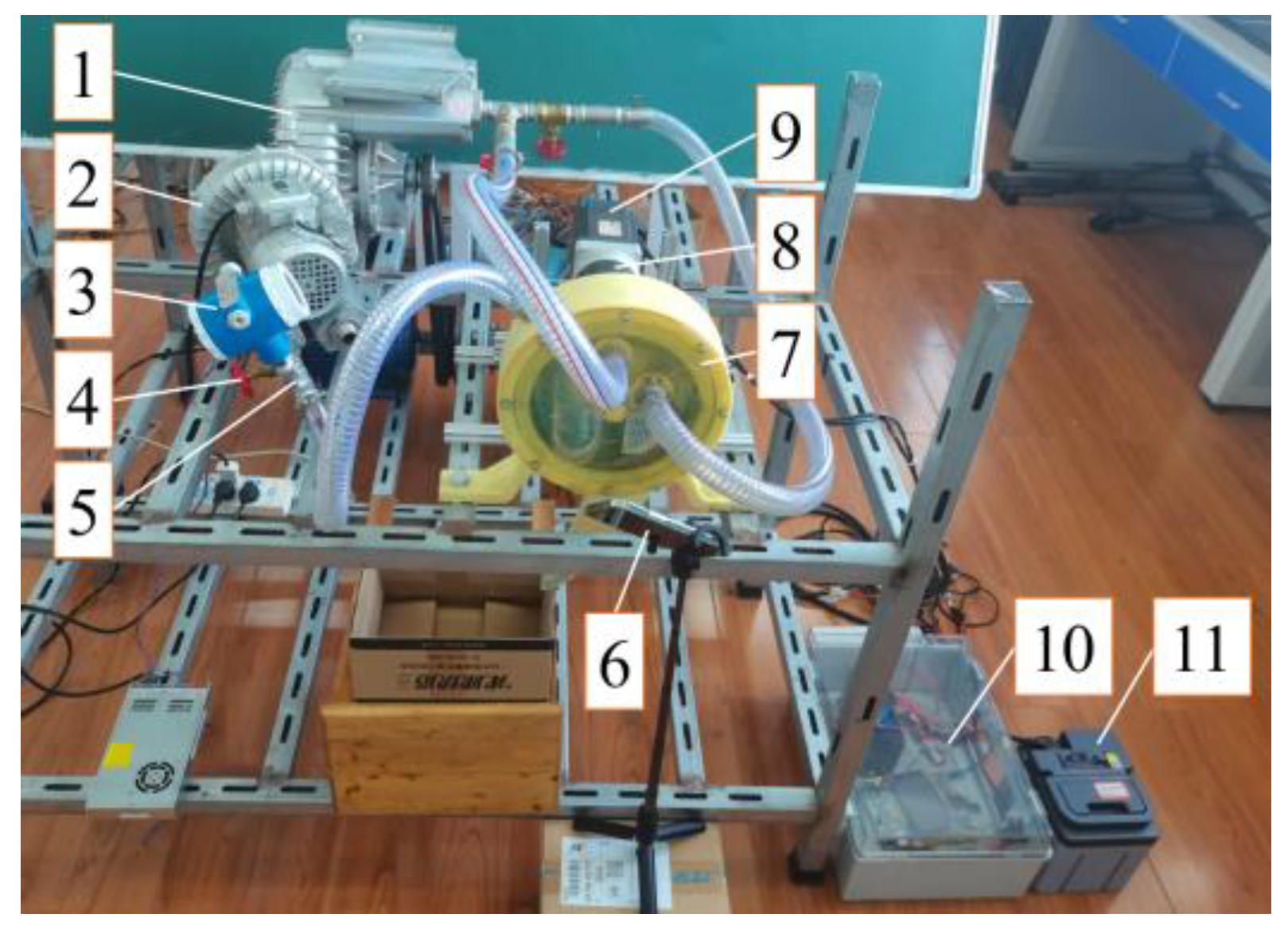


| Levels | Test Factors | ||
|---|---|---|---|
| Seed-Cleaning Distance X1/(mm) | Seed-Disturbing Distance X2/(mm) | Seed-Disturbing Pressure X3/(Pa) | |
| −1 | 0.5 | 4.0 | 200 |
| 0 | 2.5 | 6.0 | 1600 |
| 1 | 4.5 | 8.0 | 3000 |
| Seed-Cleaning Distance/(mm) | Sharp Seed-Cleaning Scraper | Flat Seed-Cleaning Scraper | ||||
|---|---|---|---|---|---|---|
| Single Seed Rate S0/(%) | Missing Cleaning Rate M0/(%) | Excessive Cleaning Rate E0/(%) | Single Seed Rate S0/(%) | Missing Cleaning Rate M0/(%) | Excessive Cleaning Rate E0/(%) | |
| 0.5 | 86.50 | 0 | 13.50 | 21.05 | 0 | 78.95 |
| 1 | 91.67 | 2.46 | 5.87 | 61.71 | 1.16 | 37.13 |
| 1.5 | 93.25 | 5.03 | 1.72 | 85.37 | 3.74 | 10.89 |
| 2 | 92.32 | 7.25 | 0.43 | 92.11 | 5.32 | 2.57 |
| 2.5 | 91.76 | 8.10 | 0.14 | 91.24 | 7.48 | 1.28 |
| 3 | 90.60 | 9.40 | 0 | 89.06 | 10.03 | 0.91 |
| 3.5 | 86.18 | 13.82 | 0 | 84.27 | 15.35 | 0.38 |
| 4 | 80.37 | 19.63 | 0 | 82.02 | 17.98 | 0 |
| 4.5 | 75.11 | 24.89 | 0 | 76.79 | 23.21 | 0 |
| Test Serial Number | Test Factors | Evaluation Indexes | ||||
|---|---|---|---|---|---|---|
| X1 | X2 | X3 | Single Seed Rate S0/(%) | Missing Cleaning Rate M0/(%) | Excessive Cleaning Rate E0/(%) | |
| 1 | −1 | −1 | 0 | 72.82 | 0 | 27.18 |
| 2 | −1 | 1 | 0 | 82.39 | 0 | 17.61 |
| 3 | −1 | 0 | −1 | 85.47 | 0 | 14.53 |
| 4 | −1 | 0 | 1 | 65.56 | 0 | 34.44 |
| 5 | 0 | −1 | −1 | 94.98 | 4.82 | 0.2 |
| 6 | 0 | 1 | −1 | 92.19 | 7.78 | 0.03 |
| 7 | 0 | −1 | 1 | 82.59 | 0.2 | 17.21 |
| 8 | 0 | 1 | 1 | 95.45 | 2.3 | 2.25 |
| 9 | 0 | 0 | 0 | 97.93 | 1.04 | 1.03 |
| 10 | 0 | 0 | 0 | 99.26 | 0.37 | 0.37 |
| 11 | 0 | 0 | 0 | 97.69 | 2.26 | 0.05 |
| 12 | 0 | 0 | 0 | 96.86 | 1.18 | 1.96 |
| 13 | 0 | 0 | 0 | 97.09 | 2.55 | 0.36 |
| 14 | 1 | −1 | 0 | 92.97 | 3.68 | 3.35 |
| 15 | 1 | 1 | 0 | 88.64 | 10.65 | 0.71 |
| 16 | 1 | 0 | −1 | 83.95 | 16.05 | 0 |
| 17 | 1 | 0 | 1 | 95.43 | 1.25 | 3.32 |
| Source of Variation | Single Seed Rate | Missing Cleaning Rate | Excessive Cleaning Rate | ||||||
|---|---|---|---|---|---|---|---|---|---|
| Sum of Squares | F-Value | p-Value | Sum of Squares | F-Value | p-Value | Sum of Squares | F-Value | p-Value | |
| Model | 1455.48 | 161.83 | <0.0001 ** | 309.50 | 31.72 | 0.0001 ** | 1853.64 | 171.22 | <0.0001 ** |
| X1 | 374.70 | 374.95 | <0.0001 ** | 125.06 | 115.35 | <0.0001 ** | 932.69 | 775.35 | <0.0001 ** |
| X2 | 29.30 | 29.32 | 0.0010 ** | 18.09 | 16.69 | 0.0047 ** | 93.43 | 77.67 | <0.0001 ** |
| X3 | 38.54 | 38.57 | 0.0004 ** | 77.50 | 71.49 | 0.0001 ** | 225.36 | 187.34 | <0.0001 ** |
| X1X2 | 48.30 | 48.34 | 0.0002 ** | 12.15 | 11.20 | 0.0123 * | 12.01 | 9.98 | 0.0159 * |
| X1X3 | 246.33 | 246.50 | <0.0001 ** | 54.76 | 50.51 | 0.0002 ** | 68.81 | 57.20 | 0.0001 ** |
| X2X3 | 61.23 | 61.27 | 0.0001 ** | 0.18 | 0.17 | 0.6920 | 54.69 | 45.46 | 0.0003 ** |
| X12 | 521.63 | 521.99 | <0.0001 ** | 7.41 | 6.83 | 0.0347 * | 404.73 | 336.45 | <0.0001 ** |
| X22 | 24.87 | 24.89 | 0.0016 ** | 2.54 | 2.34 | 0.1699 | 11.52 | 9.58 | 0.0174 * |
| X32 | 68.48 | 68.53 | 0.0001 ** | 9.71 | 8.96 | 0.0201 * | 26.62 | 22.13 | 0.0022 ** |
| Residual | 7.00 | 7.59 | 8.42 | ||||||
| Lack of Fit | 3.45 | 1.30 | 0.3898 | 4.32 | 1.76 | 0.2930 | 6.09 | 3.49 | 0.1294 |
| Pure Error | 3.54 | 3.27 | 2.33 | ||||||
| Cor Total | 1462.48 | 317.09 | 1862.06 | ||||||
| R2 = 0.995; R2adj = 0.989; CV = 1.12%; Adeq Precision = 41.80 | R2 = 0.976; R2adj = 0.945; CV = 32.70%; Adeq Precision = 19.68 | R2 = 0.996; R2adj = 0.990; CV = 14.96%; Adeq Precision = 40.41 | |||||||
Publisher’s Note: MDPI stays neutral with regard to jurisdictional claims in published maps and institutional affiliations. |
© 2022 by the authors. Licensee MDPI, Basel, Switzerland. This article is an open access article distributed under the terms and conditions of the Creative Commons Attribution (CC BY) license (https://creativecommons.org/licenses/by/4.0/).
Share and Cite
Hu, M.; Xia, J.; Zhou, M.; Liu, Z.; Xie, D. Design and Experiment of Seed-Cleaning Mechanism for Inside-Filling Pneumatic Cotton Precision Seed-Metering Device. Agriculture 2022, 12, 1217. https://doi.org/10.3390/agriculture12081217
Hu M, Xia J, Zhou M, Liu Z, Xie D. Design and Experiment of Seed-Cleaning Mechanism for Inside-Filling Pneumatic Cotton Precision Seed-Metering Device. Agriculture. 2022; 12(8):1217. https://doi.org/10.3390/agriculture12081217
Chicago/Turabian StyleHu, Mengjie, Junfang Xia, Mingkuan Zhou, Zhengyuan Liu, and Dingyang Xie. 2022. "Design and Experiment of Seed-Cleaning Mechanism for Inside-Filling Pneumatic Cotton Precision Seed-Metering Device" Agriculture 12, no. 8: 1217. https://doi.org/10.3390/agriculture12081217
APA StyleHu, M., Xia, J., Zhou, M., Liu, Z., & Xie, D. (2022). Design and Experiment of Seed-Cleaning Mechanism for Inside-Filling Pneumatic Cotton Precision Seed-Metering Device. Agriculture, 12(8), 1217. https://doi.org/10.3390/agriculture12081217





